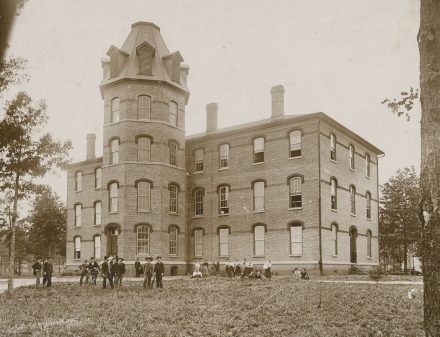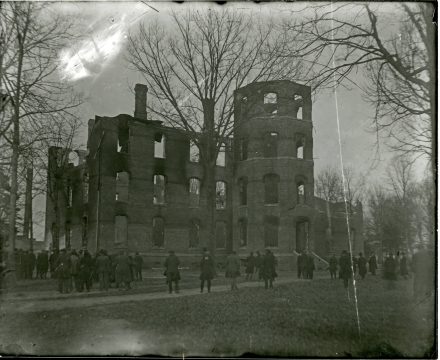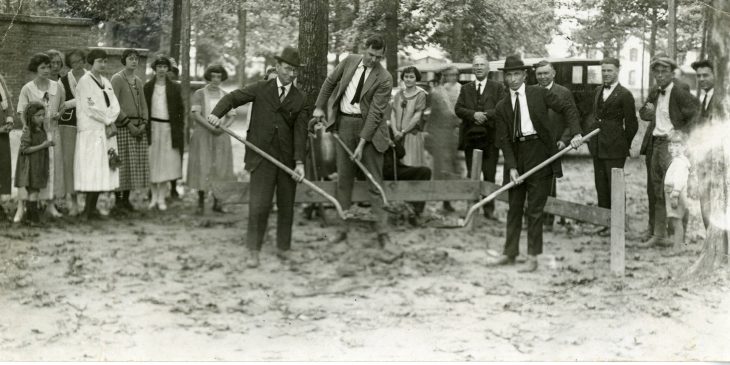A century ago today, as the ruins of Elon’s Administration Building were still smoldering after a fire, members of the college community and area residents gathered to craft plans to rebuild, setting the stage for the “bigger and better” Elon of today.

Editor’s note: This year, Elon University is commemorating the resilience and rebuilding of the institution after a 1923 fire destroyed its Administration Building and threatened the young college’s future. The article below, which was originally published in the Magazine of Elon, details the devastation of the fire and the quick response from the college and community to rebuild. Learn more at the 1923 Commemoration website.
—
It was the morning of Thursday, Jan. 18, 1923, and the first calls of “Fire! Fire!” had echoed across the pre-dawn campus just hours before. With smoke still rising from “Old Main,” as the administration building was known on campus, Elon College students, faculty, staff and townspeople were lifting up their voices in the Alumni Building gymnasium to sing “Here’s to Dear Old Elon.”
Remarkably, university historian George Troxler would note, “the mood was positive,” with the gathering closing with a rendition of “Praise God from Whom All Blessings Flow.”
The songs bookended a meeting that was laying the seeds for a new Elon to emerge from the catastrophic fire. Despite the destruction of the small college’s first and most important building, classes would be held at other locations on campus and in the community the very next morning. Construction of the first of five new academic and administrative buildings would begin that spring, with Elon’s now-iconic Alamance Building opening for classes in September.
This historic display of resilience and vision marked the first steps for a reborn college that would grow to become a nationally recognized university, one that has been heralded for the quality of its undergraduate teaching, its support for global experiences and its preparation of students for leadership positions in all fields. It is underscored by a strong connection between the school and the community, and a desire to be more and do more.
This year, Elon will commemorate the 100th anniversary of this pivotal event in its history with the theme of “Rising from the Ashes: A Century of Innovation.” The focus of the commemoration that includes cultural, academic, athletic and social events is less on the fire that destroyed, and more on the community spirit and vision that rebuilt and reimagined Elon in its aftermath.
The Fire
Student William B. “Bill” Terrell was wrapping up his duties in the college’s power plant shortly after 6 a.m. on Jan. 18 when he first spotted the light. A 25-year-old U.S. Army veteran who worked at the power plant to offset his tuition and room costs, Terrell saw a light in a second-floor classroom in Main Building, which should have been dark at that hour of the day.

Main, also called the Administration Building, was a three-story building central to campus with a distinctive octagonal tower at its main entrance. It was home to an auditorium, library, society halls, a chapel, an observatory, faculty and administrative offices and most of the college’s classrooms. As noted in the 1923 edition of the Phi Psi Cli yearbook, “It was the nucleus out of which has evolved the splendid institution we know today as Elon.”
At the time, power was shut off to Main and the rest of the campus overnight and then turned back on in the morning, and Terrell’s first thought was the light had been left switched on overnight and illuminated when power was restored that morning. But when he saw the light flicker, he knew it meant fire.
As Troxler and other historians have noted in recounting the morning’s events, Terrell ran to the building to ring the college bell high in Main’s tower and alert the campus. He arrived to find the tower already filled with smoke and flames consuming the building. Running back to the power plant to alert the Burlington and Gibsonville fire departments, Terrell yelled, “Fire! Fire!” to wake students sleeping in the nearby dormitories.
“Although students quickly formed a bucket brigade, and both fire departments arrived within 10 minutes of the call, the heart of pine of which the interior was built burned quickly,” Troxler wrote in his history, “From a Grove of Oaks: The History of Elon University.” “There was a strong north wind, and the efforts were focused on preventing it from spreading the fire to other buildings and to nearby residences. Fearing their dormitories would burn, women and men moved their trunks and personal items out of their rooms and onto the lawn.”

As the student-run Maroon and Gold newspaper reported in its edition published the day after the fire, there was little hope of saving the building once the fire took hold. “The flames had the right of way throughout the interior of the building, and the equipment was doomed before the students could have begun the fight,” the front-page story recounts.
The cause of the fire would never be determined. The campus was devastated and heartbroken.
Appearing in the Jan. 19 Maroon and Gold was a piece penned at what must have been an exhausting day titled, “The Broken Heart of Elon.” It exemplified the blow the college had received, but the resilience its supporters still felt.
“The broken, crumbling walls of the Administration building were to the solemn onlookers symbolic of the rended heart of Elon; but the tall stately walls of the tower, standing defiantly against the strong wind that was sweeping down upon the scene of devastation, were symbolic of the staunch undying spirit of loyalty and service that permeated the hearts of every friend who knew of Elon’s loss. … Already the students, faculty and friends have lifted their tear-dimmed eyes from the ruins of what was once the Administration Building and have turned them toward a bigger and better Elon.”
Months later, a tribute in Phi Psi Cli noted that “while it is fitting that we pause to mourn the loss of this fine old building, it is more fitting that we turn our eyes toward the future, with the realization of what, through our efforts, our college may become.”
The Rebuilding

That “bigger and better Elon” had already begun to take shape within hours of the fire. During the morning meeting in the Alumni Building gymnasium called by Elon President William A. Harper 1, students and faculty spoke, offering assurances that they were committed to the college, with Harper reading telegrams read “from friends throughout the country assuring the college of their support and cooperation in rebuilding a bigger and a better Elon,” according to the Maroon and Gold account.
Meetings the day of the fire focused on how classes could resume the following morning, and where. Members of the community supported the effort, with classes held in the local Masonic and Junior Order lodge halls and a new room in the local post office. English, Bible, French and history classes took place in the girls’ gymnasium, and Professor J.U. Newman opened up his home for Greek and Bible classes.
Among the casualties of the fire was the safe in President Harper’s office on the third floor of Main, which plummeted to the ground during the blaze and cracked, with nearly all student and alumni records burning. Troxler’s history notes that Registrar Claude M. Cannon began interviewing students the day of the fire to find out what classes they had taken, what grades they had received, what scholarships they had been awarded and what expenses they had paid.
Out of the ashes of the building and the depression naturally arising from such a loss, we heard not one despairing thought expressed — every one seemed to be straining his vision to see what he could discover in the way of the best things for Elon College and her future usefulness.
Less than a week after the fire, the college’s trustees met in the president’s temporary office in East Dormitory and were joined by Leon Edgar Smith, then the president of the Southern Christian Convention and later to become Elon’s president. Initial plans took shape to build at least four new buildings to take the place of Main, with an Emergency Fund committee tasked with raising $600,000 — half for the new building program and the other half for the college’s endowment.
Among those at the meeting was Editor J. Pressley Barrett of The Christian Sun, a weekly publication of the Southern Convention of Christian Churches. In a February column in the Sun about his visit to Elon, Barrett recounts that the group decided to develop a building plan for Elon “for the next hundred years.” That plan would grow to include five new buildings — an administration building (Alamance Building), an auditorium (Whitley Auditorium), a Christian education building (Duke Building), a library (Carlton Building) and a science building (Mooney Building).
“Out of the ashes of the building and the depression naturally arising from such a loss, we heard not one despairing thought expressed — every one seemed to be straining his vision to see what he could discover in the way of the best things for Elon College and her future usefulness,” Barrett wrote.
Key to the building effort was the surrounding community. As Barrett notes in his account, the residents of Burlington and Alamance County had committed to raise $100,000 of the $600,000 goal of the Emergency Fund committee. Even the local Elon College Boy Scout troop lent a hand to the building effort, cleaning bricks from Main Building that had not been damaged so that they could be reused in future buildings. In recognition of all the community was doing to help rebuild Elon, the new administration building was named Alamance. Three years after the fire, President Harper would report to the college’s board that the school had received $484,092 for the rebuilding effort, far outpacing the original $300,000 goal.
Barrett was so impressed by the outpouring of support from neighbors to the college that he noted that “there is now arising a tidal wave of liberality on Elon’s behalf, so that it may be that the calamity of the burning of the Administration Building will at length appear as a blessing in disguise for the carrying out of this larger building and endowment program.”
On March 21, just two months after the fire, the first brick for Alamance Building was laid by Col. Robert L. Holt, who was leading the Emergency Fund campaign in Alamance County. In another two months, on May 29, 1923, following the morning’s commencement exercises held in front of West Dormitory — Under the Oaks — the cornerstone was laid for Alamance Building.
As classes began in September 1923, Alamance Building hosted the first among generations of students to walk its halls as Elon began its own march toward the university it is today.
Commemorating the Fire
To commemorate the 100th anniversary of the 1923 fire and celebrate Elon’s spirit of innovation, the university is planning a yearlong series of observances, which include:
January 18:
1923 Commemoration Community Breakfast
January 31:
Commemorative College Coffee
February 3:
Campus Conversation: Developing Individual and Community Resilience
February 28:
A Century of Innovation: the discussion
More details about these and other events will be posted on the 1923 Commemoration website.
1 Elon President William A. Harper’s complicated career invites readers to grapple with the meaning of white progressivism in the early 20th Century, as he was among those who championed education as well as racist ideologies. Visit this Teachable Moment page for more information.


